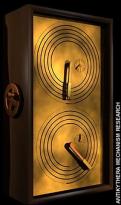 |
|
|
Ancient Greek Computer Reveals its Secrets |
|
|
An ancient astronomical calculator made at the end of the 2nd century BC was amazingly accurate and more complex than any instrument for the next 1,000 years, scientists said on Wednesday.
The Antikythera Mechanism is the earliest known device to contain an intricate set of gear wheels. It was retrieved from a shipwreck off the Greek island of Antikythera in 1901 but until now what it was used for has been a mystery. |
 |
|
Although the remains are fragmented in 82 brass pieces, scientists from Britain, Greece and the United States have reconstructed a model of it using high-resolution X-ray tomography. They believe their findings could force a rethink of the technological potential of the ancient Greeks.
"It could be described as the first known calculator," said Professor Mike Edmunds, a professor of astrophysics at Cardiff University in Wales. "Our recent work has applied very modern techniques that we believe have now revealed what its actual functions were." STAGGERINGLY SOPHISTICATED The calculator could add, multiply, divide and subtract. It was also able to align the number of lunar months with years and display where the sun and the moon were in the zodiac. Edmunds and his colleagues discovered it had a dial that predicted when there was a likely to be a lunar or solar eclipse. It also took into account the elliptical orbit of the moon. "The actual astronomy is perfect for the period," Edmunds told Reuters. "What is extraordinary about the thing is that they were able to make such a sophisticated technological device and to be able to put that into metal," he added. The model of the calculator shows 37 gear wheels housed in a wooden case with inscriptions on the cover that related to the planetary movements. Francois Charette, of the Ludwig-Maximilians University in Munich, Germany, said the findings, reported in the journal Nature, provide a wealth of data for future research. "Newly deciphered inscriptions that relate to the planetary movements make it plausible that the mechanism originally also had gearings to predict the motion of the planets," he said in a commentary. Edmunds described the instrument as unique, saying there is nothing like it in the history of astronomy. Similar complicated mechanisms were not been seen until the appearance of medieval cathedral clocks much later. "What was not quite so apparent before was quite how beautifully designed this was," he said. "That beauty of design in this mechanical thing forces you to say 'Well gosh, if they can do that what else could they do?"' The device performs subtractions, multiplications and divisions to carry out its functions. That leads to the question "of whether they could have easily designed actual calculators for other purposes," Edmunds said. The identity of the maker will probably remain a mystery — no signature is apparent on the device. But the astronomical information incorporated in the gears clearly is based on the calculations of the Greek astronomer Hipparchus, who worked on Rhodes from about 140 BC to about 120 BC. Subsequently, the philosopher Posidonius established an astronomy school incorporating Hipparchus' ideas. Cicero, the Roman lawyer and consul, later wrote that Posidonius had made an instrument "which at each revolution reproduces the same motions of the sun, the moon and the five planets that take place in the heavens every day and night." Historians have generally dismissed Cicero's words as extravagant or even mythic, but the new discoveries suggest he may have been correct. |
|
|
|
|
|
(Posting date 11 January 2007) HCS encourages readers to view other articles and releases in our permanent, extensive archives at the URL http://www.helleniccomserve.com/contents.html. |
|
|
|
|
2000 © Hellenic Communication Service, L.L.C. All Rights Reserved.
http://www.HellenicComServe.com |
|
